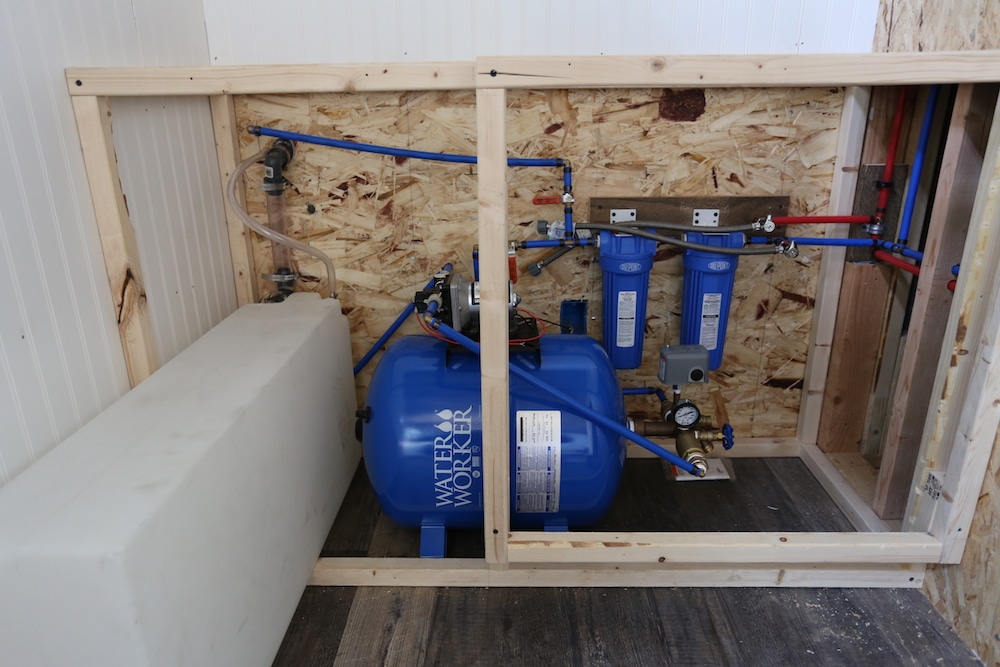Ever wondered how tiny home dwellers manage their water needs with sustainable living ideas, using gallons in ways that don’t compromise on sustainability or convenience? Navigating the intricacies of tiny home water solutions, including gallons and power ways for sustainable living, can seem like a daunting task, but fear not! From innovative rainwater harvesting systems to compact, eco-friendly filtration units fitting into trailers, there’s a world of options designed for sustainability and handling gallons of water, all tailored to fit the unique constraints of tiny living. This post dives into the essentials of selecting and implementing sustainable living water solutions that keep your tiny house living space thriving for tiny house owners interested in the tiny house movement. Let’s explore how you can make big waves with your tiny home’s water system by fitting a trailer on the side.
Exploring Water Supply Options for Tiny Homes
Municipal Systems
Municipal water is common in cities. It’s reliable and easy to connect. But, tiny homes often move. This makes municipal water not always an option.
Tiny homes on wheels face challenges here. Tiny house owners need a stable location to tap into city water as a right of the tiny house movement. Those who park their trailer on one side benefit most from this water usage system.
Well Water
Well water suits rural tiny homes best. It requires land and an initial investment though. Drilling a well isn’t cheap but provides independence from city systems for water usage and meets fresh water needs, especially relevant to the tiny house movement.
The taste of well water varies greatly. Some find it better than municipal supplies. Others may need filters to improve the flavor of fresh water or remove contaminants to meet their water needs.
Rainwater Collection
Collecting rainwater is eco-friendly and practical in many areas.
-
Pros: Lowers bills, reduces dependence on external sources.
-
Cons: Requires space for water tanks, legal restrictions apply in some places.
Location affects your ability to collect rain effectively. Areas with frequent droughts pose challenges for rainwater collection systems.
Location plays a big role in choosing your tiny home’s water source. Urban settings favor municipal connections; rural ones might lean towards wells or rainwater systems.
Legal considerations can complicate things too. Some places limit or forbid certain types of water collection or usage. It’s essential to research local water laws before settling on a solution.
Choosing the Best Water Source
Quality and Safety
Assessing water quality is crucial. Not all sources are safe for drinking. You must test them first. This ensures your health isn’t at risk.
Different sources have different safety levels. Wells might need more testing than municipal supplies. But, both can have issues like contamination or shortages.
Cost Analysis
Comparing well installation to municipal hookup is important. Let’s break it down:
-
Wells: High initial cost but lower long-term expenses.
-
Municipal water connection: Lower setup costs but you pay regular bills.
Think about what fits your budget and lifestyle best.
Environmental Impact
Choosing a water source also means considering the planet. Here’s how they stack up:
-
Wells can be a great option if used responsibly.
-
Municipal water systems offer broad access but may strain resources in dry areas.
Using rainwater collection systems could lessen this impact, offering a sustainable alternative.
Plumbing Systems for Tiny Houses
System Differences
Tiny house living involves unique challenges, especially. Unlike traditional homes, tiny houses often move and have limited space. This means their water plumbing systems must be flexible and compact.
Traditional homes rely on permanent connections. They use extensive water piping under the foundation or within walls. Tiny houses, however, might use simpler water setups due to their size and mobility needs.
Key Components
For a functional tiny home water solution, several components are essential:
-
Piping materials for water: Options include PEX (cross-linked polyethylene), PVC (polyvinyl chloride), or copper. PEX is popular for its flexibility, ease of installation, and use in water systems.
-
Water heaters: Compact solutions like tankless water heaters save space while providing hot water on demand.
-
Fixtures: Every drop counts in a tiny house. Low-flow faucets and showerheads help conserve water. A flush toilet can be chosen if connected to sewage or septic systems and has a water supply.
Choosing the right components ensures efficient use of water, space, and resources.
DIY vs Professional
The decision between DIY or professional installation depends on skills, budget, and time.
DIYers enjoy learning new skills and saving money but face potential water-related mistakes without proper knowledge.
Professional installers offer expertise but at higher costs. They ensure the system works correctly from the start.
Greywater and Blackwater Solutions
Greywater Basics
Greywater comes from sinks, showers, and washing machines. It’s less contaminated than black water. Tiny homes can reuse greywater for gardens or toilet flushing.
To treat greywater, use filters and biodegradable soaps. This prevents harm to plants when reused outdoors. Systems range from simple to complex, based on needs.
Reusing Greywater
Options for reusing greywater include irrigation and toilet flushing. Here’s how:
-
Direct water to your garden with a proper filtering system.
-
Use it for flushing toilets by connecting the output of your sink to the toilet tank to save water.
Remember, safe reuse requires careful planning. Avoid contaminants harmful to plants or humans.
Black Water Management
Black water is from toilets and contains waste products. It requires more treatment before disposal or reuse.
Composting toilets are great in tiny homes for managing black water without needing a sewer connection. They separate liquid (water) and solid waste, reducing odor and volume through composting processes.
Benefits of composting toilets include:
-
Reduced water usage
-
Lower environmental impact
-
Production of usable compost for non-edible plants
However, they need regular maintenance to work effectively.
Rainwater Collection and Storage
Roof Catchment
Calculating your roof’s catchment area is crucial. It helps you know how much water you can collect. A larger area means more rainwater for your tiny home.
Every square foot of the roof catches about 0.6 gallons of water per inch of rainfall. This calculation shows if your strategy will work. For homes with limited space, like a trailer, this method maximizes water collection without needing extra land.
Filtration Systems
Rainwater needs filtration before use. Simple filters remove debris and dirt from the water. Then, purification systems ensure the water is safe for drinking and showering.
Filtration makes rainwater useful for various parts of daily life in a tiny home. Owners find this idea practical as it reduces reliance on external water sources.
Storage Solutions
Choosing between tanks and barrels for water storage depends on space and amount needed.
-
Water tanks offer a lot of storage but require more space.
-
Barrels are great for smaller spaces but hold less water.
Most owners prefer tanks because they provide enough water for showers, plants, and other needs throughout the day. However, barrels can be part of an efficient system too, especially when space is at a premium or if there’s less demand for stored rainwater.
Off-Grid Water Solutions
Solar Pumps
Living off-grid means finding eco-friendly ways to access water. Solar-powered water pumps are a top choice. They use sunlight to operate, making them perfect for remote areas.
These pumps bring water from underground or collect rainwater stored in tanks. This method is clean and sustainable. It doesn’t rely on traditional electricity sources, which often harm the environment, instead using water.
Water Conservation
Conserving water is crucial in off-grid living. Every drop counts outside the city’s supply lines.
Simple practices can make a big difference:
-
Fix leaks promptly.
-
Use low-flow fixtures.
-
Collect and reuse greywater for gardening.
Such steps help maintain your water supply longer without overusing resources.
Heating Options
Heating water off-grid can be challenging but innovative solutions exist. Solar water heaters are popular because they harness sunlight, an abundant resource outside urban centers.
Another option is wood-fired water heaters. These are efficient and use renewable resources but require more effort to maintain.
Sustainable Water Practices for Tiny Homes
Low-Flow Fixtures
Installing low-flow fixtures is a smart move. These fixtures use less water per minute than standard ones. For showers, faucets, and toilets, this can mean big water savings.
By choosing these, you’re not just saving water. You’re also cutting down on your utility bills. It’s a win-win for both the environment and your wallet when saving water.
Native Landscaping
Opting for native plants in your garden helps too. These plants are used to the local climate, soil, and water. They need less water than non-native varieties.
This approach reduces the need for irrigation. Your garden stays beautiful with minimal effort and resources.
Greywater Systems
Integrating greywater systems with garden irrigation is another key step. Greywater comes from sinks, showers, and washing machines. It’s not suitable for drinking but perfect for watering plants.
Using greywater means you’re recycling water effectively. This not only conserves fresh water but also benefits your garden without extra cost.
Cost Analysis of Tiny Home Water Systems
Initial Setup
The initial costs for setting up water systems in tiny homes can vary widely. Some water options are more affordable upfront but may lead to higher expenses over time.
For example, installing a traditional water septic system might require a significant investment initially. On the other hand, rainwater collection systems or composting toilets can be cheaper to set up but demand more effort and maintenance.
Long-Term Savings
Investing in sustainable water solutions often leads to considerable savings down the road. Solar water heaters and greywater recycling systems have higher setup costs. Yet, they drastically reduce monthly bills.
By choosing these water-saving options, homeowners not only save money but also contribute to environmental conservation. The key is weighing upfront costs against future benefits.
Maintenance Expenses
All water systems need regular maintenance to function efficiently. Traditional plumbing might seem less demanding at first glance. However, unexpected repairs can add up quickly.
Systems like rainwater harvesting require consistent upkeep too. Cleaning gutters and filters is essential for their effectiveness.
Rebates and Incentives
Many regions offer incentives for adopting sustainable practices. These can significantly offset the initial costs of eco-friendly water solutions.
-
Tax credits
-
Rebates for specific equipment purchases
Exploring these water options before deciding on a system could lead to substantial savings.
Final Remarks
Navigating the waters of tiny home living means making smart, sustainable choices, especially about your water. You’ve explored options, weighed costs, and considered the environment. Now, it’s about taking the plunge. Whether it’s rainwater collection or a full off-grid system, your decision can ripple out, influencing not only your lifestyle but also the planet. Think of your tiny home as a drop in the ocean—small, yes, but with the power to create waves of change in water conservation.
So, what’s your next move? Dive deeper into sustainable practices or maybe fine-tune your existing water system. Remember, every drop counts in making a difference. Let’s make those choices that keep our tiny homes and big blue planet, including water, thriving. Ready to make a splash? Let’s get to it!


